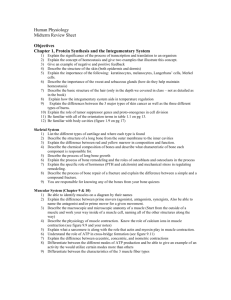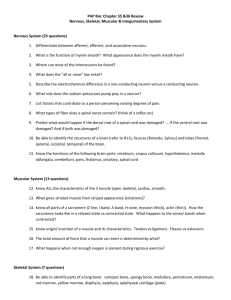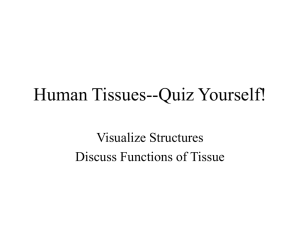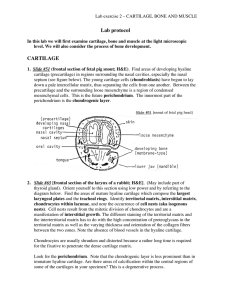Exam #2 will consist of 50 multiple choice questions. You will have
advertisement
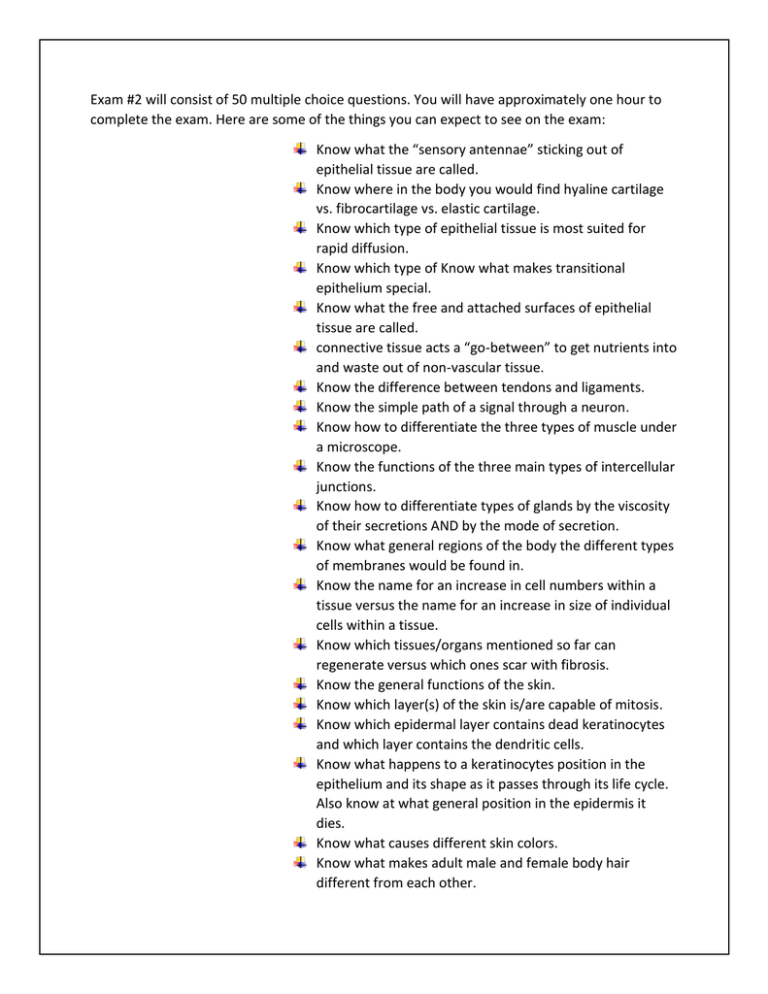
Exam #2 will consist of 50 multiple choice questions. You will have approximately one hour to complete the exam. Here are some of the things you can expect to see on the exam: Know what the “sensory antennae” sticking out of epithelial tissue are called. Know where in the body you would find hyaline cartilage vs. fibrocartilage vs. elastic cartilage. Know which type of epithelial tissue is most suited for rapid diffusion. Know which type of Know what makes transitional epithelium special. Know what the free and attached surfaces of epithelial tissue are called. connective tissue acts a “go-between” to get nutrients into and waste out of non-vascular tissue. Know the difference between tendons and ligaments. Know the simple path of a signal through a neuron. Know how to differentiate the three types of muscle under a microscope. Know the functions of the three main types of intercellular junctions. Know how to differentiate types of glands by the viscosity of their secretions AND by the mode of secretion. Know what general regions of the body the different types of membranes would be found in. Know the name for an increase in cell numbers within a tissue versus the name for an increase in size of individual cells within a tissue. Know which tissues/organs mentioned so far can regenerate versus which ones scar with fibrosis. Know the general functions of the skin. Know which layer(s) of the skin is/are capable of mitosis. Know which epidermal layer contains dead keratinocytes and which layer contains the dendritic cells. Know what happens to a keratinocytes position in the epithelium and its shape as it passes through its life cycle. Also know at what general position in the epidermis it dies. Know what causes different skin colors. Know what makes adult male and female body hair different from each other. Know what gives hair different colors and textures. Know the names of the growth, degenerative, and resting stages of the hair cycle. Know which type of gland produces earwax. Know which types of skin cancer are usually most lethal and least lethal. Know which layers of skin are involved in first vs second vs third degree burns. Know the names for the shaft and ends of a long bone. Identify the outer sheath of bone that heals bone and connects bone to other tissues. Know the overall general function of osteogenic cells, osteocytes, osteoblasts, and osteoclasts. Know the relationship between the central canal, lamellae, and canaliculi in an osteon. Know the main hemopoietic tissue in bone. Know what bone develops from in endochondral ossification. Know the difference between interstitial growth and appositional growth. Know what mineral resorption is and what type of cell accomplishes it. Know what PTH does and how it does it. Know the correct order of the stages of healing bone fractures. Know the proteins involved in blocking and exposing the active sites on actin in skeletal muscle. Know what the boundaries of an individual sarcomere are. Know the difference between the mechanisms behind spastic paralysis versus flaccid paralysis. Know the normal resting membrane potential of a neuron. Know what does and doesn’t affect twitch strength in a muscle fiber. Know isotonic versus isometric muscle contraction. Know how cardiac and smooth muscle compare to skeletal muscle in terms of contraction speed and fatigue. Know where sodium and potassium concentrations are higher/lower in a resting neuron (inside/outside cell). Know the characteristics of local potentials in a neuron. Know the order in which the Na+ and K+ channels open and close during a complete action potential.


